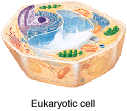General Introduction
Lists
Organization
Origins of the Eukarya
Introduction
Cell Membranes and Walls
Cytoskeleton
General Metabolism
Internal Membranes
Chromosome and Genome
Abrupt Concluding Remarks

| Eukarya | ||
| Eukarya | Eukarya Home |
| Life | Time |
| Abbreviated Dendrogram Life
├─Eubacteria
└─┬─Archaea
└─Eukarya
├─Metamonada
└─┬─Discicristata
└─┬─Rhizaria
└─┬─┬─┬─Alveolata
│ │ └─Chromista
│ └─Plantae
└─Stem Metazoa
├─Fungi
└─Metazoa
|
Contents
EukaryaGeneral Introduction Lists Organization Origins of the Eukarya Introduction Cell Membranes and Walls Cytoskeleton General Metabolism Internal Membranes Chromosome and Genome Abrupt Concluding Remarks  |
 Organisms in which the genetic material is contained within a nuclear membrane are known as Eukaryotes, the name means "true kernel". This domain includes all multicellular forms of life: Plants, Fungi, and Animals. However, in this section, we will deal only with the group classically called "Protista," single-celled Eukarya. In fact, the line is a bit vague. By convention, slime molds are treated as "protists" while sponges and Cnidaria or at least most of them, as we will see) are treated as Metazoa. Similar uncertainty marks the borderlands of the plants and fungi.
Organisms in which the genetic material is contained within a nuclear membrane are known as Eukaryotes, the name means "true kernel". This domain includes all multicellular forms of life: Plants, Fungi, and Animals. However, in this section, we will deal only with the group classically called "Protista," single-celled Eukarya. In fact, the line is a bit vague. By convention, slime molds are treated as "protists" while sponges and Cnidaria or at least most of them, as we will see) are treated as Metazoa. Similar uncertainty marks the borderlands of the plants and fungi.
Unlike prokaryotes, (the Archaea and Eubacteria) the Eukarya have a more compartmentalized cellular structure. These structures have sometimes been very different from the compartments of the average plant or animal cell. However, all eukaryotes confine the bulk of their genetic material in a well-defined nucleus surrounded by a membrane. The eukaryote cell also usually includes organelles such as mitochondria, which combine carbohydrates and fatty acids with oxygen to generate energy, and/or chloroplasts, which carry out photosynthesis, gathering energy from sunlight and storing it in the form of carbohydrates. According to the standard explanation, these particular organelles evolved through a symbiotic association of specialized prokaryotic organisms, each providing a different function and gradually evolving into organelles within a single eukaryotic cell. Almost all eukaryotes also possess -- in varying degrees -- a complex cytoskeleton of microfibrils and microtubules which maintain the integrity of the cellular compartments and organelles, as well as a number of different types of internal membrane-bound structures with specialized functions.
With eukaryotes also came sexual reproduction, which opened up tremendous variability within a species through the shuffling of genes parents, as opposed to simple binary fission. This in turn changed the fundamental nature of evolution and genetic transmission. (For discussion of an alternate paradigm possibly applicable to early prokaryotes, see A Different Kind of Evolution.)
Both prokaryotes and eukaryotes evolved in environments in which oxygen was scarce or absent. However, the diversification of eukaryotes seem to be linked to the rise in atmospheric oxygen during the Middle Proterozoic era. Perhaps it was at this time that many eukaryotes acquired mitochondria and chloroplasts, or perhaps the compartmentalized cell design of the eukaryotes was simply well suited to aerobic metabolism. The nature of the linkage remains a matter of speculation, and many eukaryotic forms retain an essentially anaerobic metabolism.
For the first two thirds or so of their history, eukaryotes remained unicellular. It was probably only in the Ediacaran Era that macroscopic multicellular life appeared. But that is another part of the story altogether. This section concerns the single-celled Eukarya, most of which have no fossil record.
MAK020323, ATW040120 (with thanks to S. Connor for pointing out some problems in an earlier version).
A. Glossary of terms and abbreviations.
A B C D E F G H I J K L M N O P Q R S T U V W X Y Z
B. Taxon Index: alphabetical list of taxa.
A B C D E F G H I J K L M N O P Q R S T U V W X Y Z
C. References: literature citations by author.
A B C D E F G H I J K L M N O P Q R S T U V W X Y Z
Our original concept was to adopt a phylogenetic organization, similar to our approach to the Vertebrates. Unfortunately, the study of the basal Eukarya ("Protistology"), is at some distance yet from the kind of phylogenetic certainty that prevails among the vertebrates. Nevertheless, after 18 months of experimentation, we're now convinced that our current "best-guess dendrogram" is fairly stable. So, with considerable trepidation, we're trotting out this tree for testing. In simplified, form, it proceeds as follows:
The derivation of this arrangement is discussed at Top Level Dendrograms.
The clade uniting plants and animals doesn't seem to have a name, so we have given it one, "Metabiotiformes," for convenience. Until more of the high-level taxa are filled in, your best bet will probably be to consult the alphabetical index of taxa.